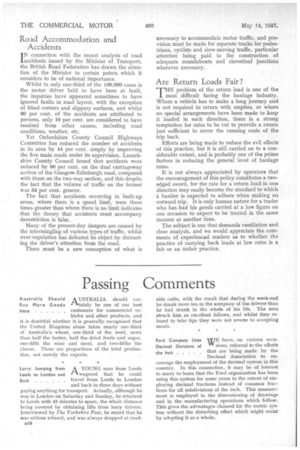Road Accommodation and Accidents
Page 28

If you've noticed an error in this article please click here to report it so we can fix it.
IN connection with the recent analysis of road !accidents issued by the Minister af Transport, the British Road Federation has drawn the attention of the Minister to certain points which it considers to be of national importance.
Whilst in only one-third of the 100,000 cases is the motor driver held to have been at fault, the inquiries have appeared sometimes to have ignored faults in road layout, with the exception of blind corners and slippery surfaces, and whilst 90 per cent. of the accidents are attributed to persons, only 10 per cent. are considered to have resulted from other causes, including road conditions, weather, etc.
Yet Oxfordshire County Council Highways Committee has reduced the number of accidents in its area by 44 per cent, simply by improving the five main roads under its supervision. Lanarkshire County Council found that accidents were reduced by 80 per cent, on the dual carriageway section of the Glasgow-Edinburgh road, compared with those on the two-way section, and this despite the fact that the volume of traffic on the former was 34 per cent. greater.
The fact that accidents occurring in built-up areas, where there is a speed limit, were three times greater than where there is no limit indicates that the theory that accidents must accompany derestriction is false.
Many of the present-day dangers are caused by the intermingling of various types of traffic, whilst over-regulation has defeated its object by distracting the driver's attention from the Toad.
There must be a new conception of what is necessary to accommodate motor traffic, and provision must be made for separate tracks for pedestrians, cyclists and slow-moving traffic, particular attention being paid to the construction of adequate roundabouts and cloverleaf junctions wherever necessary.




















































































